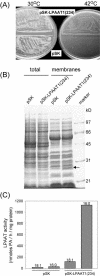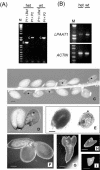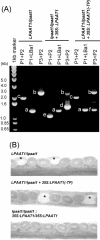Plastid lysophosphatidyl acyltransferase is essential for embryo development in Arabidopsis
- PMID: 14976237
- PMCID: PMC389945
- DOI: 10.1104/pp.103.035832
Plastid lysophosphatidyl acyltransferase is essential for embryo development in Arabidopsis
Abstract
Lysophosphatidyl acyltransferase (LPAAT) is a pivotal enzyme controlling the metabolic flow of lysophosphatidic acid into different phosphatidic acids in diverse tissues. A search of the Arabidopsis genome database revealed five genes that could encode LPAAT-like proteins. We identified one of them, LPAAT1, to be the lone gene that encodes the plastid LPAAT. LPAAT1 could functionally complement a bacterial mutant that has defective LPAAT. Bacteria transformed with LPAAT1 produced LPAAT that had in vitro enzyme activity much higher on 16:0-coenzyme A than on 18:1-coenzyme A in the presence of 18:1-lysophosphatidic acid. LPAAT1 transcript was present in diverse organs, with the highest level in green leaves. A mutant having a T-DNA inserted into LPAAT1 was identified. The heterozygous mutant has no overt phenotype, and its leaf acyl composition is similar to that of the wild type. Selfing of a heterozygous mutant produced normal-sized and shrunken seeds in the Mendelian ratio of 3:1, and the shrunken seeds could not germinate. The shrunken seeds apparently were homozygous of the T-DNA-inserted LPAAT1, and development of the embryo within them was arrested at the heart-torpedo stage. This embryo lethality could be rescued by transformation of the heterozygous mutant with a 35S:LPAAT1 construct. The current findings of embryo death in the homozygous knockout mutant of the plastid LPAAT contrasts with earlier findings of a normal phenotype in the homozygous mutant deficient of the plastid glycerol-3-phosphate acyltransferase; both mutations block the synthesis of plastid phosphatidic acid. Reasons for the discrepancy between the contrasting phenotypes of the two mutants are discussed.
Figures







Similar articles
-
Ubiquitous and endoplasmic reticulum-located lysophosphatidyl acyltransferase, LPAT2, is essential for female but not male gametophyte development in Arabidopsis.Plant Cell. 2005 Apr;17(4):1073-89. doi: 10.1105/tpc.104.030403. Epub 2005 Mar 16. Plant Cell. 2005. PMID: 15772283 Free PMC article.
-
Loss of plastidic lysophosphatidic acid acyltransferase causes embryo-lethality in Arabidopsis.Plant Cell Physiol. 2004 May;45(5):503-10. doi: 10.1093/pcp/pch064. Plant Cell Physiol. 2004. PMID: 15169931
-
A plastidial lysophosphatidic acid acyltransferase from oilseed rape.Plant Physiol. 1999 Jul;120(3):913-22. doi: 10.1104/pp.120.3.913. Plant Physiol. 1999. PMID: 10398728 Free PMC article.
-
The structure and functions of human lysophosphatidic acid acyltransferases.Front Biosci. 2001 Aug 1;6:D944-53. doi: 10.2741/leung. Front Biosci. 2001. PMID: 11487472 Review.
-
The lysophosphatidic acid acyltransferases (acylglycerophosphate acyltransferases) family: one reaction, five enzymes, many roles.Curr Opin Lipidol. 2018 Apr;29(2):110-115. doi: 10.1097/MOL.0000000000000492. Curr Opin Lipidol. 2018. PMID: 29373329 Review.
Cited by
-
Lysophosphatidic acid acyltransferase 2 and 5 commonly, but differently, promote seed oil accumulation in Brassica napus.Biotechnol Biofuels Bioprod. 2022 Aug 12;15(1):83. doi: 10.1186/s13068-022-02182-2. Biotechnol Biofuels Bioprod. 2022. PMID: 35962411 Free PMC article.
-
At4g24160, a soluble acyl-coenzyme A-dependent lysophosphatidic acid acyltransferase.Plant Physiol. 2009 Oct;151(2):869-81. doi: 10.1104/pp.109.144261. Epub 2009 Aug 21. Plant Physiol. 2009. PMID: 19700561 Free PMC article.
-
The significance of C16 fatty acids in the sn-2 positions of glycerolipids in the photosynthetic growth of Synechocystis sp. PCC6803.Plant Physiol. 2006 Jun;141(2):546-56. doi: 10.1104/pp.105.075796. Epub 2006 Apr 7. Plant Physiol. 2006. PMID: 16603667 Free PMC article.
-
Eukaryotic lipid metabolic pathway is essential for functional chloroplasts and CO2 and light responses in Arabidopsis guard cells.Proc Natl Acad Sci U S A. 2018 Sep 4;115(36):9038-9043. doi: 10.1073/pnas.1810458115. Epub 2018 Aug 20. Proc Natl Acad Sci U S A. 2018. PMID: 30127035 Free PMC article.
-
Arabidopsis ATG8-INTERACTING PROTEIN1 is involved in autophagy-dependent vesicular trafficking of plastid proteins to the vacuole.Plant Cell. 2014 Oct;26(10):4084-101. doi: 10.1105/tpc.114.129999. Epub 2014 Oct 3. Plant Cell. 2014. PMID: 25281689 Free PMC article.
References
-
- Beisson F, Koo AJK, Ruuska S, Schwender J, Pollard M, Thelen J, Paddock T, Salas J, Savage L, Milcamps A et al. (2003) Arabidopsis thaliana genes involved in acyl lipid metabolism: a 2003 census of the candidates, a study of the distribution of ESTs in organs and a Web-based database. Plant Physiol 132: 681-697 - PMC - PubMed
-
- Bouvier-Nave P, Benveniste P, Oelkers P, Sturley SL, Schaller H (2000) Expression in yeast and tobacco of plant cDNAs encoding acyl CoA: diacylglycerol acyltransferase. Eur J Biochem 267: 85-96 - PubMed
-
- Brown AP, Brough CL, Kroon JTM, Slabas AR (1995) Identification of a cDNA that encodes a 1-acyl-sn-glycerol-3-phosphate acyltransferase from Limnanthes douglasii. Plant Mol Biol 29: 267-278 - PubMed
-
- Brown AP, Coleman J, Tommey AM, Watson MD, Slabas AR (1994) Isolation and characterization of a maize cDNA that complements a 1-acyl-sn-glycerol-3-phosphate acyltaransferase mutant of Escherichia coli and encodes a protein which similarities to other acyltransferases. Plant Mol Biol 26: 211-223 - PubMed
Publication types
MeSH terms
Substances
LinkOut - more resources
Full Text Sources
Other Literature Sources
Molecular Biology Databases

